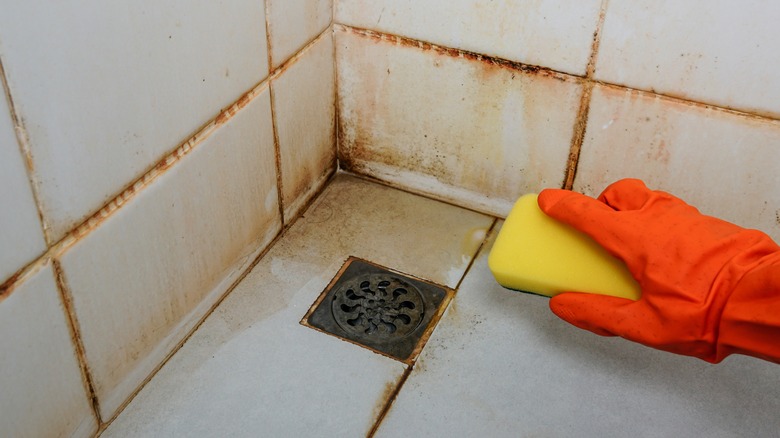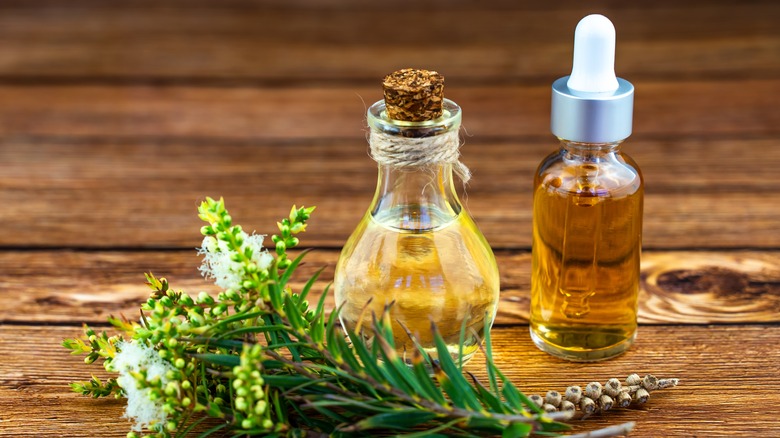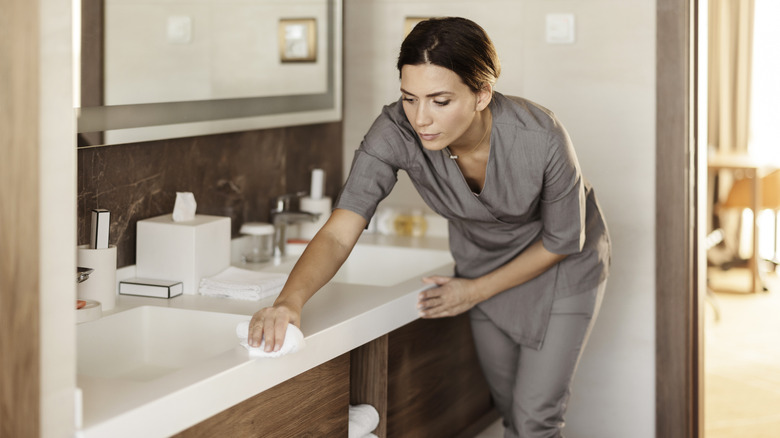The Essential Oil That Can Help Target Mold On Bathroom Tile
If mold has taken over your bathroom, don't despair. There's a natural, potent solution right at your fingertips: tea tree oil. This isn't just based on anecdotal evidence; the scientific backing for tea tree oil as a mold inhibitor is substantial. Tea tree oil, hailing from the Australian native tea tree, has been a go-to antiseptic for centuries. Its potent antimicrobial properties make it an ideal ally in your fight against bathroom mold. A 2005 study published in the Journal of Allergy and Clinical Immunology highlighted its effectiveness against a variety of indoor fungi, including the infamous Stachybotrys Chartarum, Aspergillus Niger, Penicillium sp., and Cladosporium sp. These names might sound like something out of a science fiction novel, but they're very real — and very common — household mold problems.
What gives tea tree oil its mold-fighting superpower? It's primarily due to a component called terpinen-4-ol. This compound works like a microscopic warrior, attacking and breaking down the cell walls of mold and other microorganisms. But it's not just about its mold-busting capabilities. Tea tree oil is also known for its refreshing, clean scent, a welcome change from the often harsh, chemical smells of conventional mold cleaners. Furthermore, it's a multipurpose solution — besides cleaning, there are various ways to use tea tree oil in the home. That being said, knowing how to use this oil effectively for cleaning is crucial for maximizing its mold-battling capabilities.
Cleaning bathroom mold with tea tree oil
When tackling mold in the bathroom, it's important to know where to look. Mold has a sneaky way of creeping into nooks and crannies where moisture lingers. The usual suspects besides the bathroom ceilings and walls include tiles and grout. These areas, along with shower curtains and the vents of exhaust fans, are mold's favorite hideouts, thanks to the constant dampness they're exposed to. When identifying mold, keep in mind that mold isn't just one color; it's a rainbow of trouble. You might see black, green, white, or even orange or purple shades. Each hue represents a different type of mold, with the most toxic being black mold. So, when tackling mold, especially the black variety, it's vital to wear a mask and protective gear.
When mixing your mold-fighting solution, combine one teaspoon of tea tree oil with a cup of water. When the solution is ready, it's time to go on the offensive. Spray it generously on moldy spots. Give it a few minutes to sit and do its magic. This pause allows the tea tree oil to penetrate the mold and do its job effectively. Then, gently wipe away the area where you've applied the solution. You might need to apply it regularly to ensure those sneaky spores don't get a chance to regroup and come back with a vengeance. Be sure to do a skin test first, as tea tree oil may irritate some people.
Preventing mold in the bathroom
In addition to using tea tree oil for cleaning, there are various other ways to prevent mold from making your bathroom its home. Mold loves moisture and condensation, so the key is to keep things dry and airy. Think of your bathroom as a living space that needs to breathe just like you do. Start with ventilation. Every time you take a shower or a bath, let the room air out. If you have an exhaust fan, use it. If you don't have a fan or window, leave the doors open so air from other rooms can enter. Using a dehumidifier can also be a game-changer.
Moving on to your shower routine. After you're done showering, take a minute to wipe down the walls and shower doors with a squeegee. Regular cleaning is also vital. Make it a habit to clean your bathroom weekly. Use your tea tree oil mixture or other natural cleaners to keep surfaces clean and mold-free. Another tip is to watch out for your bath mats and towels. Make sure to hang them up to dry after each use, and wash them regularly. Consider investing in mats and towels that dry quickly or have antimicrobial properties. Lastly, stay vigilant. Regularly inspect under the sink and around the tub for mold before it becomes a bigger problem.


